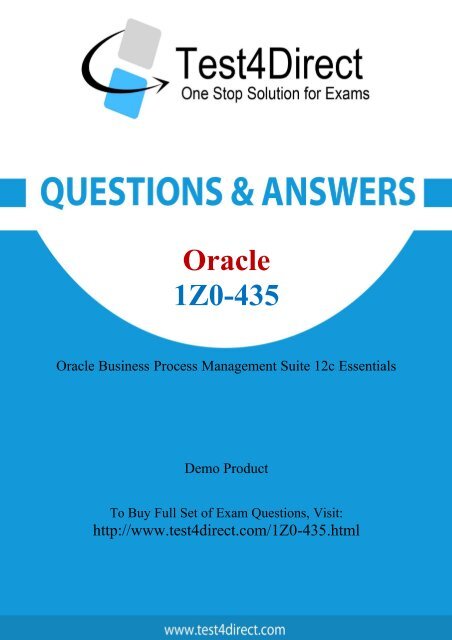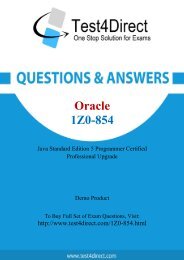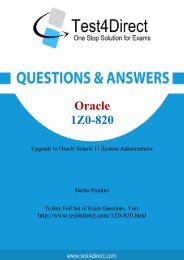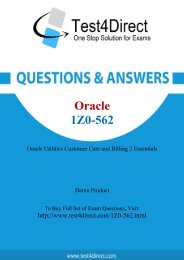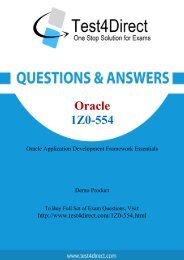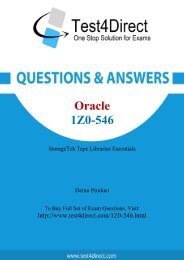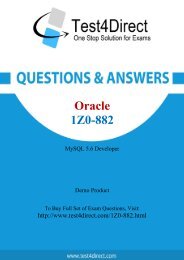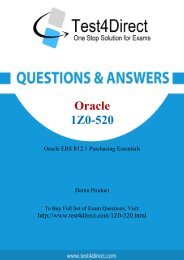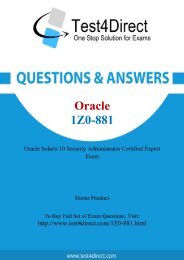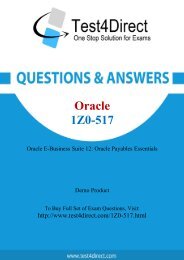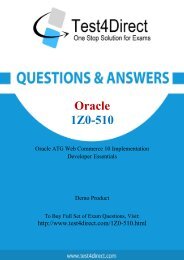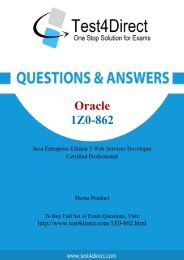1Z0-435 BrainDumps For Best Results
Test4Direct provides latest PDF questions of Oracle 1Z0-435 exam. You have an opportunity to pass the Oracle 1Z0-435 exam in one go. Test4Direct is most accurate source to prepare Oracle 1Z0-435 exam as your success will become site’s responsibility after purchasing 1Z0-435 exam product. There are also lots of discounts and promotion offers that you can avail. Let’s try a free demo http://www.test4direct.com/1Z0-435.html
Test4Direct provides latest PDF questions of Oracle 1Z0-435 exam. You have an opportunity to pass the Oracle 1Z0-435 exam in one go. Test4Direct is most accurate source to prepare Oracle 1Z0-435 exam as your success will become site’s responsibility after purchasing 1Z0-435 exam product. There are also lots of discounts and promotion offers that you can avail. Let’s try a free demo http://www.test4direct.com/1Z0-435.html
Create successful ePaper yourself
Turn your PDF publications into a flip-book with our unique Google optimized e-Paper software.
Oracle<br />
<strong>1Z0</strong>-<strong>435</strong><br />
Oracle Business Process Management Suite 12c Essentials<br />
Demo Product<br />
To Buy Full Set of Exam Questions, Visit:<br />
http://www.test4direct.com/<strong>1Z0</strong>-<strong>435</strong>.html
Question: 1<br />
Which two statements are true about the role of Oracle Business Rules in Adaptive Case<br />
Management (ACM)?<br />
A. Defining business rules is mandatory to be able to build, deploy, and run an ACM project.<br />
B. Business rules are used to handle case events and take specific actions on the case.<br />
C. Business rules are used to activate conditional case activities.<br />
D. Oracle Business Rules is an optional component of ACM.<br />
Question: 2<br />
Which two features are provided on the Tasks page of Business Process Workspace?<br />
A. Display Status for Adaptive Case Management (ACM) cases.<br />
B. View human tasks based on the user’s permissions and assigned groups and roles.<br />
C. Create personal to-do tasks that are unassociated with a process instance.<br />
D. View who is currently assigned to a task that the current user has completed.<br />
Question: 3<br />
Question: 4<br />
Answer: C, D<br />
Answer: B, C<br />
Explanation:<br />
The Tasks page displays tasks for the user based on the user's permissions and assigned groups and<br />
roles.<br />
Perform authorized actions on tasks in the worklist, acquire and check out shared tasks, define<br />
personal to-do tasks, and define subtasks.<br />
Reference:<br />
http://docs.oracle.com/middleware/1213/bpm/bpm -user/bpmug_ws_gt_strt.htm#BPMUG121<br />
Which statement is true about a case activity that is defined as “Automatic” and “Conditional”?<br />
A. The activity is run automatically as soon as the case starts.<br />
B. The activity is run by the system only after it is initiated by the user.<br />
C. The activity is automatically run by the system as soon as it is activated by a case rule.<br />
D. Only a BPMN case activity can be defined as “Automatic” and “Conditional”.<br />
Answer: B<br />
You have a requirement to dynamically assign tasks at run time based on the employee’s title. Which<br />
three could be used to accomplish this assignment? (Choose three.)
A. Use parametric roles to map the individual parametric role assignments and then map individual<br />
users to specific titles in the workspace using extended user properties.<br />
B. Use parametric roles to map the individual parametric role assignments and then map LDAP<br />
groups to specific titles in the workspace using extended user properties.<br />
C. In LDAP, ensure that individual users have been given titles and, in the workspace, associate the<br />
LDAP title attribute to a parametric role.<br />
D. Use a business rule in the human task to dynamically assign work items to specific users or an<br />
LDAP group based on employee title.<br />
E. In the process, edit the properties of the swimlane and assign a “title” string data object in the<br />
process payload to define a parametric role.<br />
Question: 5<br />
Which human workflow service is used to get the list of outcomes defined for a task?<br />
A. IRuntimeConfigService<br />
B. ITaskQueryService<br />
C. ITaskService<br />
D. ITaskMetadataService<br />
Explanation:<br />
Query the list of tasks using ITaskQueryService.<br />
Reference:<br />
http://docs.oracle.com/cd/E15586_01/integration.1111/e10224/bp_worklistcust.htm<br />
Question: 6<br />
Question: 7<br />
Answer: A, B, D<br />
Answer: B<br />
When automatically generating an ADF form from a human task, the difference between using the<br />
“Auto-Generate Task <strong>For</strong>m” and the “Launch Task <strong>For</strong>m Wizard” is that the _____.<br />
A. “Launch Task <strong>For</strong>m Wizard” option launches a six-step “BPM Custom <strong>For</strong>m Wizard” and the “Auto-<br />
Generate” option creates the ADF project, task flow, and ADF form with one key click<br />
B.“Launch Task <strong>For</strong>m Wizard” option does not create a new ADF project every time it is run<br />
C. “Auto-Generate” option gives you the choice to use an existing ADF page template as the form is<br />
being created.<br />
D. “Launch Task <strong>For</strong>m Wizard” option automatically creates an ADF page template and task flow<br />
template<br />
Which pattern is best handled by using Adaptive Case Management?<br />
Answer: D
A. straight-through processing requiring no manual intervention<br />
B. deterministic, human-centric processes<br />
C. knowledge-based work requiring collaboration<br />
D. application integration processes<br />
Answer: C<br />
Question: 8<br />
Which two statements are correct on the use of business objects in a BPM project? (Choose two.)<br />
A. A business object is defined by a complex data time.<br />
B. Business objects are often defined in WSDL documents.<br />
C. A business object can inherit data and behavior from a parent business object.<br />
D. You can create a business object at either the project level or the process level.<br />
Question: 9<br />
Question: 10<br />
Answer: B, C<br />
The initial performer of a task is determined by the role associated with the swim lane in which the<br />
task is modeled except when you use a(n) _______.<br />
A. complex task<br />
B. user task<br />
C. FYI task<br />
D. group task<br />
Answer: A<br />
Explanation:<br />
A complex user task uses a complex routing flow that is defined within the humantask.BPM Studio<br />
offers a number of human task patterns out of the box, to make it easy to implementthe most<br />
common types of human tasks. <strong>For</strong> example, the Simple pattern just assigns individualusers or<br />
groups. The Management pattern is used for a sequential list of approvers up themanagement chain.<br />
Initiator is for the person who kicks off the process.<strong>For</strong> most of these,swimlane roles are used to<br />
determine assignments. <strong>For</strong> the Complex task, however, the swimlaneis irrelevant, and routing and<br />
assignments are typically more complicated.Note: Swimlanes are the horizontal lines that run across<br />
the process editor. All flow objects mustbe placed within a swimlane.Swimlanes can also be used to<br />
group flow objects based on the roles defined within your process.Swimlanes that contain user tasks<br />
must have roles assigned to them. Swimlanes visually displaythe role responsible for performing<br />
each flow object within your process. Additionally, you canhave multiple swimlanes that are assigned<br />
to the same role.Swimlanes can make your process more readable when you must use the same role<br />
in differentparts of the same process.<br />
Which two modeling approaches could be used to handle exceptions thrown by a service? (Choose<br />
two.)
A. subprocess<br />
B. event subprocess<br />
C. error and event<br />
D. error catch event as a boundary event on the service task<br />
Answer: B, D<br />
Explanation:<br />
You can handle the exceptions that occur in an activity using the following:<br />
*A boundary error catch event<br />
*An event subprocessBoundary error catch events enable you to resume the main process flow after<br />
handling theexception.If you want to reuse the exception handling flow for multiple tasks in your<br />
process, then eventsubprocesses are more efficient than boundary catch events. Event subprocesses<br />
enable you todefine a cleaner process with less effort because the catch error event is located within<br />
the eventsubprocess. To reuse an exception handling flow using boundary catch events, you must<br />
define aboundary catch event for each of the tasks, and then connect those boundary events to<br />
theexception handling flow.
THANKS FOR TRYING THE DEMO OF OUR PRODUCT<br />
Visit Our Site to Purchase the Full Set of Actual <strong>1Z0</strong>-<strong>435</strong> Exam Questions With Answers.<br />
http://www.test4direct.com/<strong>1Z0</strong>-<strong>435</strong>.html<br />
We Also Provide Practice Exam Software That Simulates Real Exam Environment And Has<br />
Many Self-Assessment Features. Download Free Product Demo From:<br />
http://www.test4direct.com/<strong>1Z0</strong>-<strong>435</strong>.html<br />
Money Back Guarantee<br />
Check Out Our Customer Testimonials


